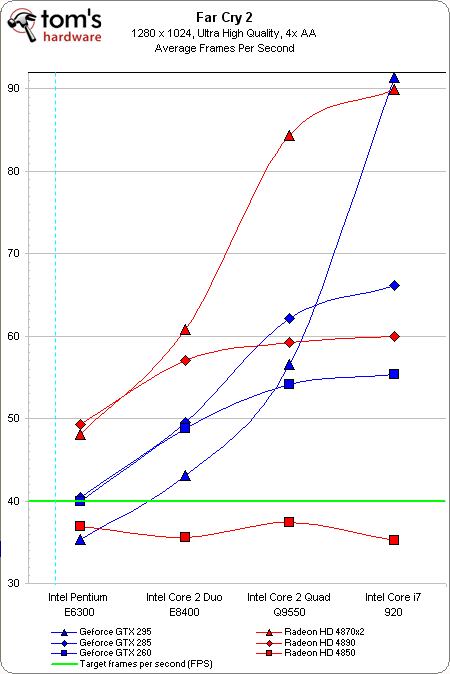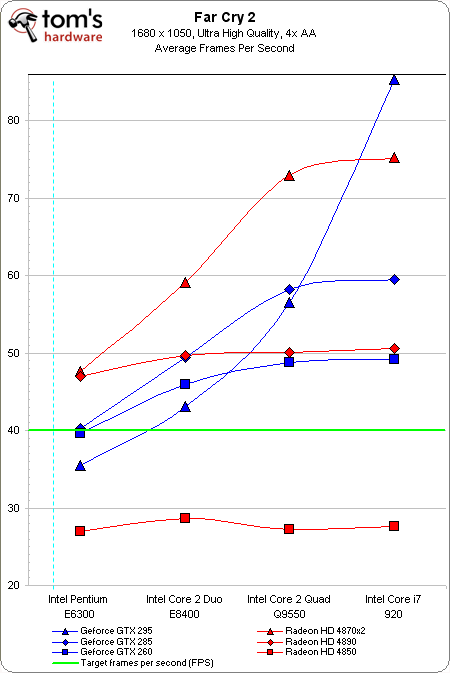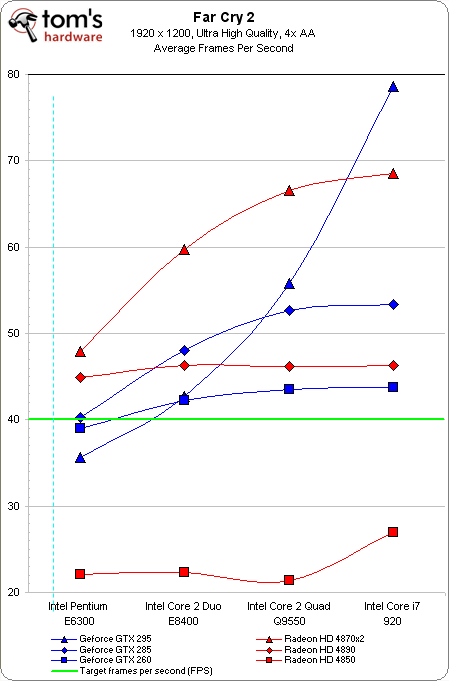Part 1: Building A Balanced Gaming PC
Benchmark Results: Far Cry 2
Far Cry 2
Far Cry 2 contains a built-in benchmarking tool that enables CPU-intensive physics effects, does a decent job of delivering consistent results, and represents actual game-play. There certainly may still be some more graphically-demanding areas of the map, but 40 FPS in the small ranch demo is a fair target for playability. Here we crank details to Ultra quality and also enable 4x AA to smooth out the jaggies.

The Radeon HD 4850 once again fails to reach our target with these cranked-up quality settings across all four CPUs.
Unlike Crysis, the quartet of processors now manages to reach the minimum acceptable performance line, so we do not have a “too little CPU” quadrant in this title. The GeForce GTX 260 and Pentium E6300 represent our minimum recommended platform by averaging exactly 40.0 FPS. But further observation shows the game is clearly optimized for more than two CPU cores, and the GeForce GTX 260 benefits from being paired with our two quad-core chips. The Radeon HD 4890 puts up impressive performance, and is fairly balanced with the Core 2 Duo E8400 or higher. You obviously don’t need a dual-GPU monster for this resolution, but given enough CPU power, the Radeon HD 4870 X2 and GeForce GTX 295 leave the single-GPU cards far behind.

When it's matched up to the Pentium E6300, Nvidia's GeForce GTX 260 and GeForce GTX 285 straddle the line at 39.6 FPS and 40.2 FPS, respectively. But both pick up significant performance boosts when paired with a more powerful CPU.
The Radeon HD 4890 manages about seven frames per second higher than the GeForce GTX 285 when it's coupled with the Pentium E6300, and the same performance advantage when paired with the Core 2 Duo E8400.
But once we install a quad-core CPU, the GeForce GTX 285 flexes its muscles and claims its spot as the top single-GPU solution. Radeon HD 4870 X2 and GeForce GTX 295 owners will see no benefits from their dual-GPU beasts at this particular setting unless the card is paired with a powerful-enough CPU.
Get Tom's Hardware's best news and in-depth reviews, straight to your inbox.

Performance with the Radeon HD 4890 levels off at 1920x1200, representing a good balance, even when it's paired with the two dual-core CPUs. If you want to see any significant frame rate increase, we need to step up to the Radeon HD 4870 X2 with an E8400 or above, or the GeForce GTX 285/295 paired with a quad-core processor.

Only the top GPU solutions survive at our highest resolution, and to do so, each requires more CPU power than the Pentium E6300 can provide. Reaching 39.9 FPS, it’s hard to not include the GeForce GTX 285 in the mix. Otherwise, it’s the Radeon HD 4870 X2/E8400 combination or the GeForce GTX 295 paired with a quad-core CPU that best represent the level of platform needed to max out Far Cry 2.
Current page: Benchmark Results: Far Cry 2
Prev Page Benchmark Results: Crysis Next Page Benchmark Results: S.T.A.L.K.E.R.: Clear Sky-
yoy0yo Wow, this is an amazingly in depth review! I kinda feel that its sponsered by Asus or Corsair, but I guess you kept with the same brand for the sake of controls etc.Reply
Thankyou! -
inmytaxi Very helpful stuff.Reply
I'd like to see some discussion on the availability of sub $400 (at times as low as $280) 28" monitors. At this price range, does it make more sense to spend more on the LCD even if less is spent initially on graphics? I would think the benefit of 28" vs. 22" is so great that the extra money could be taken from, say, a 9550 + 4890 combo and getting a 8400/6300 + 4850 instead, with the right motherboard a second 4850 later will pass a 4890 anyway. -
frozenlead I like the balance charts. It's a good way to characterize the data. This article is well constructed and well thought-out.Reply
That being said - is there a way we can compile this data and compute an "optimized" system for the given hardware available? Finding the true, calculated sweet spot for performance/$ would be so nice to have on hand every quarter or twice a year. I'll have to think about this one for a while. There may be some concessions to make, and it might not even work out. But it would be so cool. -
Neggers I feel like the person that did this review got it finished alittle bit late. I can only assume he did all the testing some months back and has only just finished writing up his results. But its sad to not see the new P55/i5 Systems, AMD Athlon II Quad Cores, or the Radeon 5000 series.Reply
Good review, but hopefully it can be updated soon with some of the newer equipment thats out, to turn it into a fantastic guide for people. -
brockh Great job, this is the information people need to be seeing; the way people provide benchmarks these days hardly tells the story to most of the readers. It's definitely important to point out the disparities in ones CPU choice, rather than just assuming everyone uses the i7 all the sites choose. ;)Reply
Looking forward to part 2. -
Onyx2291 This will take up some of my time. Even though I know how, it's nice to get a refresher every now and then.Reply -
mohsh86 you are really kidding me by not considering the ATI 5000 series, although am a fan of nvidia , but this is not fair !Reply